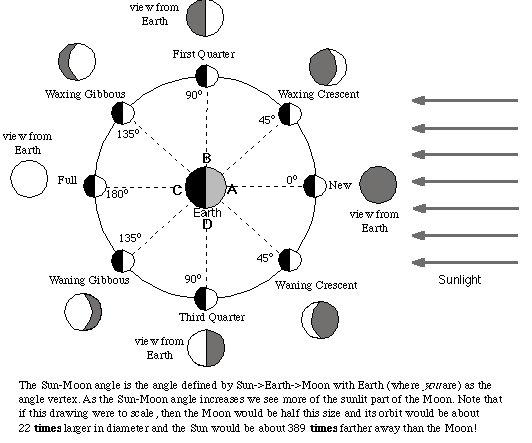
Video lecture for this chapter
One of the most familiar things about the Moon is that it goes through phases from new (all shadow) to first quarter (1/2 appears to be in shadow) to full (all lit up) to third quarter (opposite to the first quarter) and back to new. This cycle takes about 29.53 days. This time period is known as the Moon's synodic period. Because the Moon moves through its phases in about four weeks, the phases of new moon, first quarter, full moon, third quarter occur nearly one week apart from each other.
Select this link to find the phase for any date and time between 1800--2199 (will display in another window). A picture of the Moon will be shown.
The phases are due to how the Sun illuminates the Moon and the relative positioning of the Earth, Moon, and Sun. The figure below shows that as the Moon orbits the Earth, the fraction of its illuminated side that you can see from the Earth changes. From high above the Earth and Moon orbit, you can see that the Moon is always half lit by the Sun and the lit half (the illuminated side, or day side) always faces the light source---the Sun. The other half (night side) faces away from the Sun. The figure below combines two view points. The half-lit moon on the inner circle around the Earth is the Moon as viewed from high above the Earth and Moon orbit. The outer ring of Moon pictures in various phases is the view of the Moon as we would see it from the Earth. Of course, this drawing is not to scale. Notice that the waning gibbous, third quarter, and waning crescent phases as seen from Earth are lit on the left side. The waxing vs. waning diagram below shows how this can be even though the Sun in the figure here is on the right side (one rotates the picture 180°, so the observer at D is facing up).

You will observe only a small fraction of the Moon's illuminated side when it is close to the Sun. In fact, the smaller the angular distance between the Moon and the Sun, the less of its illuminated side you see. When the angular distance is less than 90° separation, you on the Earth will see less than half of the Moon's illuminated (day) side and it will look like a a curved sliver of light---the crescent phase. You will see mostly the night side of the Moon. Because the Moon is spherical, the boundary between light and shadow (night) is curved. Note that the figure of the phase angles above shows just one of the angles possible for the crescent phase (at 45°). When the angle between Sun and Moon is within about 6 degrees you on the Earth see it in a new phase and it is the beginning of the phase cycle. Sometimes that angle = 0 degrees and you have a solar eclipse---the moon is in new phase and it is covering up the Sun. The Earth's shadow always points directly away from the Sun (and it tapers down to a point). At new phase the Moon is in the same direction as the Sun as seen from the Earth, so the Earth's shadow cannot be why you just see the night side of the Moon.
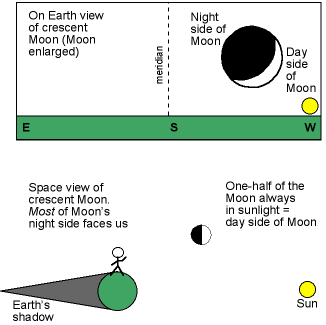
The sequence of pictures below shows a technique you can use to figure out how a Moon phase will look from the Earth when you start from an "orrery" or space view of the Moon, i.e., how to translate from the orrery (space) view of the Moon in its orbit around the Earth to the ground-based view. To show the technique, let's use the Waxing Crescent example.
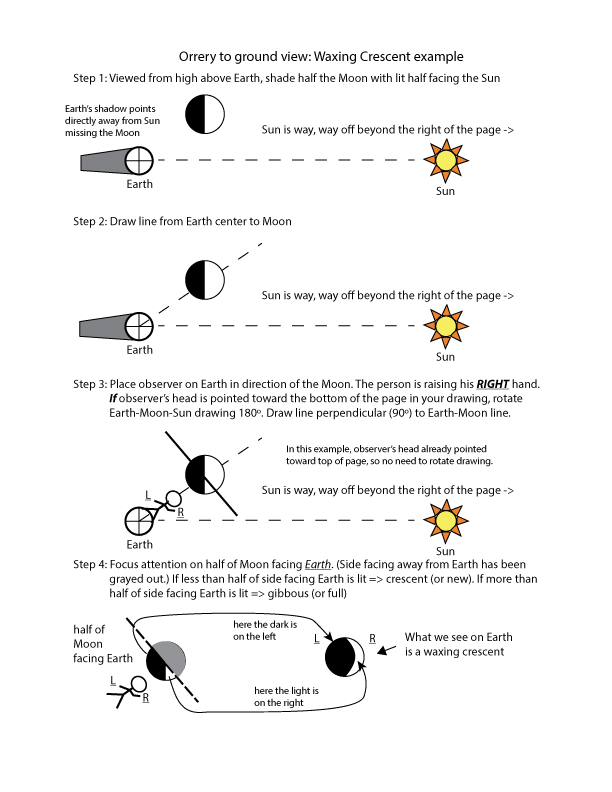
At 90° angular separation from the Sun, you on the Earth see half of the Moon's illuminated (day) side and half of its night side. The phase is called a quarter phase because you can see a quarter of the Moon's entire surface (and 90 degrees is one-quarter of 360 degrees). The quarter phase a week after the new phase is called first quarter.
The greater the angular distance is between the Moon and the Sun, the more of the Moon's illuminated side you can see from the Earth. When the angular distance between Sun and Moon is more than 90° separation, you on the Earth will see more than half of the Moon's illuminated (day) side---the gibbous phase. You will see a small amount of the Moon's night side. ``Gibbous'' means a shape that is convex (bulges outward) at both sides. Again note that the figure shows just one of the angles possible for the gibbous phase (at 135°). Also, note again that the Moon is always half lit up by the Sun. How much of the lit side (day side) we see from the Earth depends on where the Moon is in its orbit around the Earth.
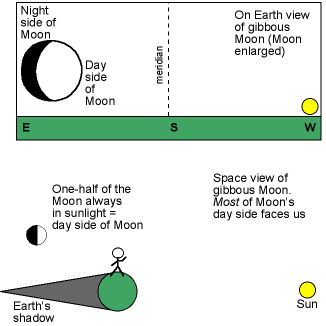
Around 180° angular separation from the Sun, you on the Earth see the entire illuminated (day) side of the Moon---the full phase. Sometimes (about twice a year) the Sun-Moon angle is exactly 180 degrees and you see the Earth's shadow covering the Moon---a lunar eclipse. Sometimes a descriptive term is added to the crescent and gibbous phases. If the amount of illuminated side you can see increases with time, it is waxing as in waxing crescent or waxing gibbous. The daylit side of the Moon will be facing toward the west (toward the right for observers in the northern hemisphere and toward the left for southern hemisphere observers). If the illuminated fraction decreases with time, it is waning as in waning crescent or waning gibbous. The daylit side of the Moon will be facing toward the east (toward the left for observers in the northern hemisphere). Readers in the southern hemisphere need to reverse "left" and "right" in the figure below.
Let's do one last example of translating from the orrery (space) view of the Moon's position in its orbit to the Earth (ground) view with the Moon in a Waning Gibbous position. Here are the sequence of steps in the figure below.
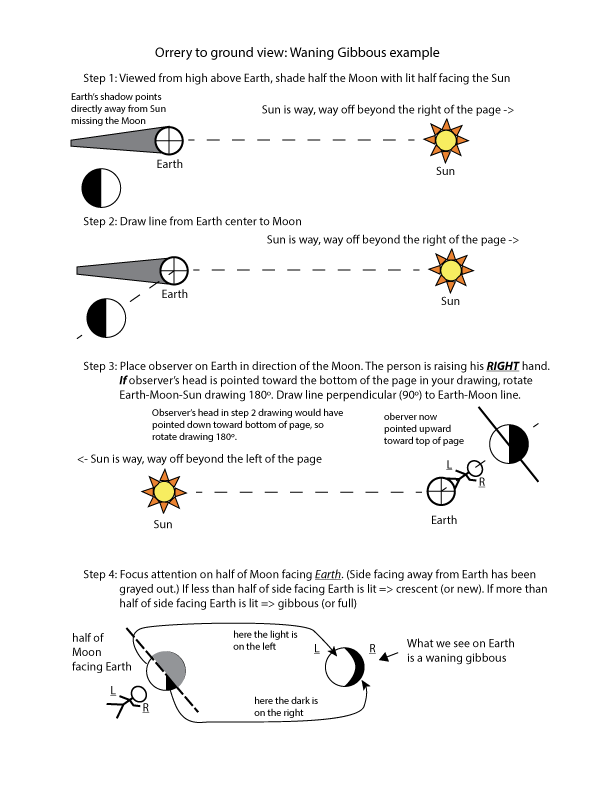
You can use the illustration of the lunar phases at the top to find out the time of day when the Moon will be visible. The Sun is at the right of the figure so a person at position (A) on the Earth (e.g., Los Angeles, CA) sees the Sun on the meridian. When an object is on the meridian, your part of the Earth is pointing directly toward that object. The Earth rotates in the counterclockwise direction (A to B to C to D). A person at position (B) (e.g., Sao Mateus in the Azores) sees the Sun setting since he is one-quarter turn (6 hours) ahead of the person at position (A). The person at position (C) (e.g., Zahedan, Iran) is at the midnight position (half a turn, 12 hours, ahead of position (A)) and the person at position (D) (e.g., Sydney, Australia) is experiencing sunrise (three-quarters of a turn, 18 hours, ahead of position (A)). If the Moon was at its new phase position, person (D) would see the new moon rising, person (A) would see the new moon on the meridian, and person (B) would see the new moon setting within a few minutes of sunset. The figure below shows the positions of the various moon phases for the different times of of day. Note that the new moon is usually above or below the Sun (not covering it up), so the picture shows two possible positions of the new moon.
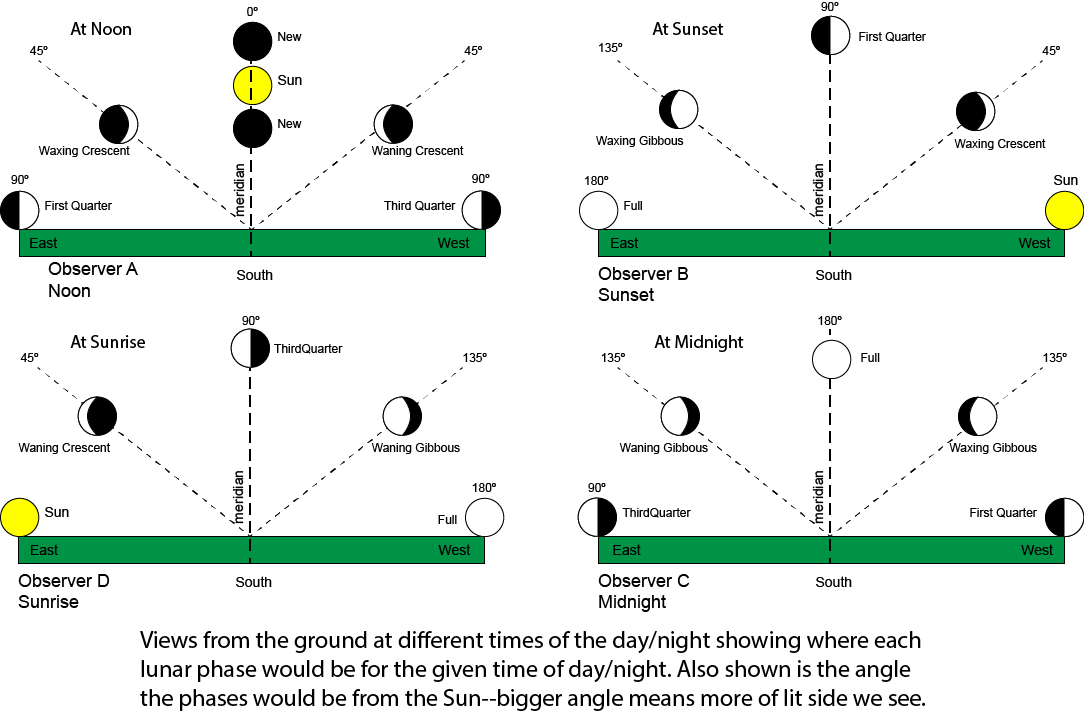
If the Moon was at its first quarter position, person (A) would see the Moon beginning to rise, person (B) would see the Moon on his meridian at sunset, and person (C) would the first quarter moon setting because it is already midnight at her position. The figure below illustrates these views.
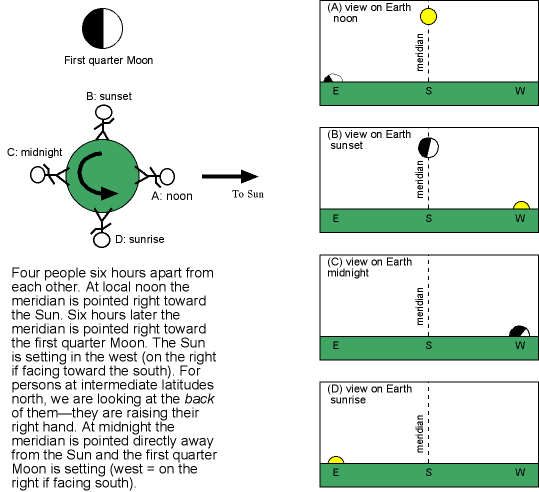
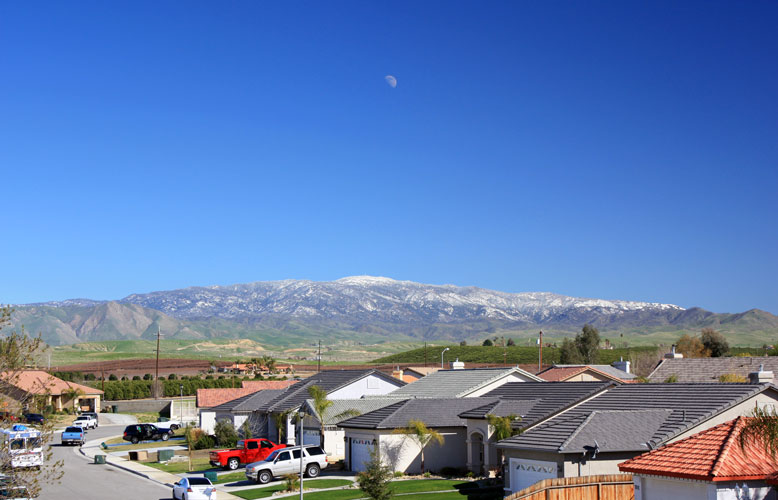
Waxing gibbous Moon one day past first quarter rises in the east at about 1:30 PM. (Select the image for an enlarged version.)
Using the same method, you can see that the full moon is rising for person (B) at sunset, is on the meridian at midnight for person (C) opposite the Sun, and is setting for the person (D) at sunrise. Now try to figure out when the third quarter moon will rise, cross the meridian, and set using this method. Remember that each of the persons A, B, C, D are each six hours apart from each other. Also, remember person (D) is facing down in the orrery view on the left side of the figure above and if the person is facing south, the Sun will be rising on his left.
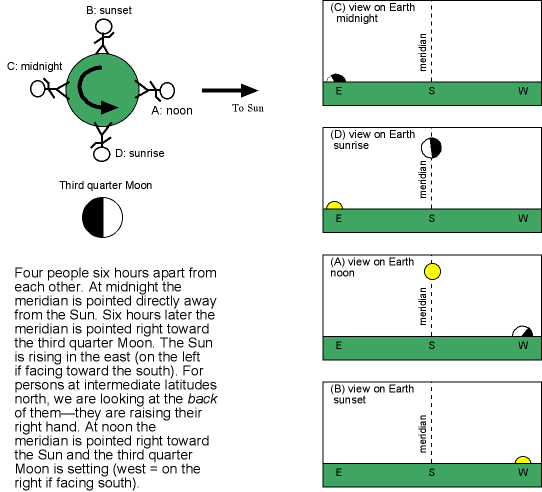
The table below shows animations of two other examples: for a waxing crescent and for a waxing gibbous. In the first quarter and third quarter orrery-ground view pictures above and in the animations in the table below, notice four key facts: 1) the observer's location on Earth always faces directly toward the Sun at noon; 2) the observer's location on Earth always faces directly away from the Sun at midnight; 3) Earth spins counter-clockwise as viewed from above the north pole; and 4) the observer's location on Earth points toward the meridian (due South) at any given time, so the meridian direction rotates with the observer (the stick figures are pointed in the meridian direction).
| Waxing crescent animation | Waxing gibbous animation |
|---|---|
The waxing crescent phase rises after sunrise and trails behind the Sun by a few hours (here 3 hours) throughout the day. |
The waxing gibbous phases rises after sunrise and trails behind the Sun by several hours (here 9 hours) throughout the day. |
If you are having a hard time visualizing this, try using a white ball (e.g., a styrofoam ball) for the Moon, a bright light bulb for the Sun, and your head for the Earth in a room shut off from other lights. When your eyes are facing the bulb, that would be noon. While facing the bulb, move the ball to your left ear so half of it is lit up. That is the first quarter phase. If you move your head counterclockwise 90° so you are facing the half-lit ball, you will see the bulb out of the corner of your right eye (in the ``west'' direction). That would be sunset. Move the ball around so it is opposite the bulb but out of the shadow of your head. You should see all of it lit up---a full phase. If you face the same direction that you faced the half-lit ball, the full phase ball would be visible out of the corner of your left eye (in the ``east'' direction). As you turn your head counterclockwise, you will see the ball ``rise'' and the bulb ``set''. When you face the full-lit ball, that would be midnight. How would you simulate a third quarter phase? See NASA/JPL's "Moon Phases" classroom activity for pictures of this demonstration.
The table gives a summary of approximately when the Moon is visible and where to look (the crescent and gibbous phases are in between the table values). You may be surprised to find out that the Moon is sometimes visible in broad daylight!
| Phase | Time the Moon is ahead/behind the Sun |
Moon Rises (eastern sky) |
Moon Crosses Meridian (southern sky) |
Moon Sets (western sky) |
|---|---|---|---|---|
| New | within few minutes | Sunrise | Noon | Sunset |
| First Quarter | 6 hrs behind | Noon | Sunset | Midnight |
| Full | 12 hrs behind | Sunset | Midnight | Sunrise |
| Third Quarter | 6 hrs ahead | Midnight | Sunrise | Noon |
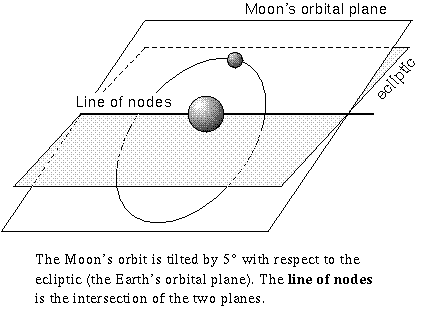
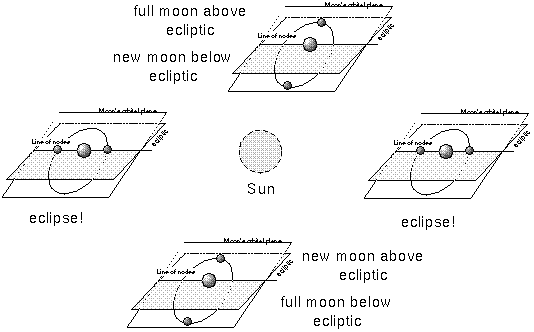
The phase diagram seems to show that a solar and lunar eclipse should happen every month but eclipses actually happen only twice a year. You can see why if you look at the Moon's orbit from close to edge-on. The Moon's orbit is tilted by 5 degrees with respect to the Earth's orbital plane (the ecliptic). In order for an eclipse to occur, the Moon must be in the ecliptic plane AND exactly at the new or full phase. Usually, the Moon crosses the ecliptic plane at another phase instead of exactly at new or full phase during its approximately month-long orbit around the Earth.
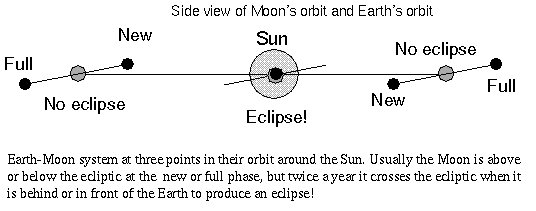
During a year the Moon's orbit is oriented in very nearly the same direction in space. The position of the Earth and Moon with respect to the Sun changes while the Moon's orbit direction is approximately fixed. So in one month the Moon will be below the ecliptic at full phase and above the ecliptic at full phase about six months later. Though the Moon crosses the ecliptic twice a month, an eclipse will happen only when it is exactly at full or new phase when it crosses the ecliptic. The tilt of the Moon's orbit explains why eclipses happen only twice a year.
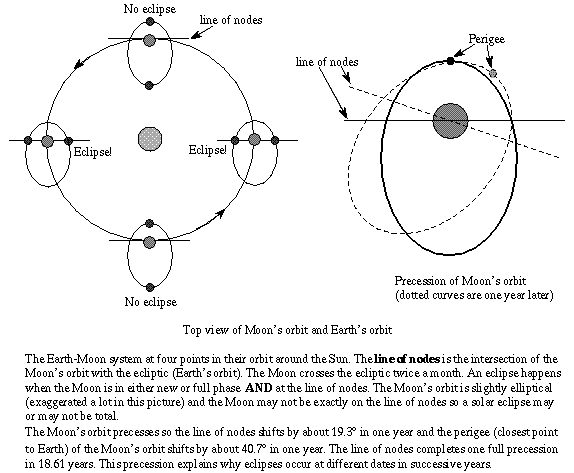
The direction of the Moon's orbit slowly shifts (precesses) over time. Because the Moon's orbit precesses, eclipses will occur on different dates in successive years. However, even if there was no precession, eclipses would still happen only twice a year. The figure above shows another complication---the elliptical orbit of the Moon around the Earth means that the new moon can occur at different distances from the Earth and the Moon's shadow may not reach the Earth if it is too far away.
The following set of pictures illustrate the effect of the Moon's elliptical orbit for full moon phases. The first picture shows two full moons side by side, one at the apogee (farthest point from Earth) and the other at the perigee (closest point to Earth). The second picture has the apogee full moon overlapping the perigee full moon. Recently, the full moon that occurs within 24 hours of reaching perigee has become known as a "supermoon" and the full moon that occurs within 24 hours of reaching apogee has become known as a "micromoon". These pictures also illustrate the fact that the phase of the Moon is in no way dependent on the distance the Moon is from Earth---there's no correlation between the Moon phase and distance from Earth.
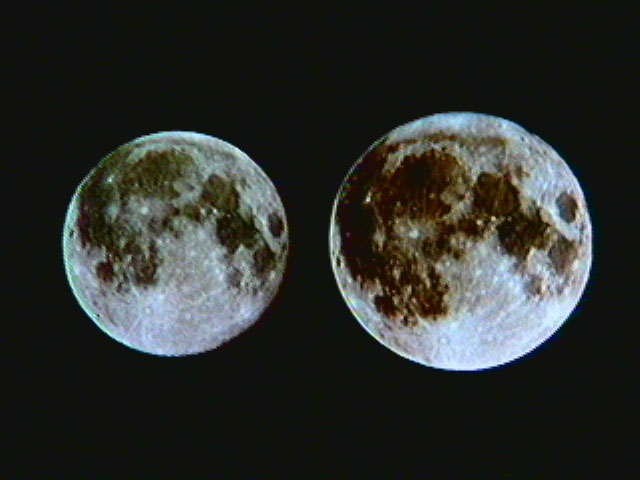 --
-- 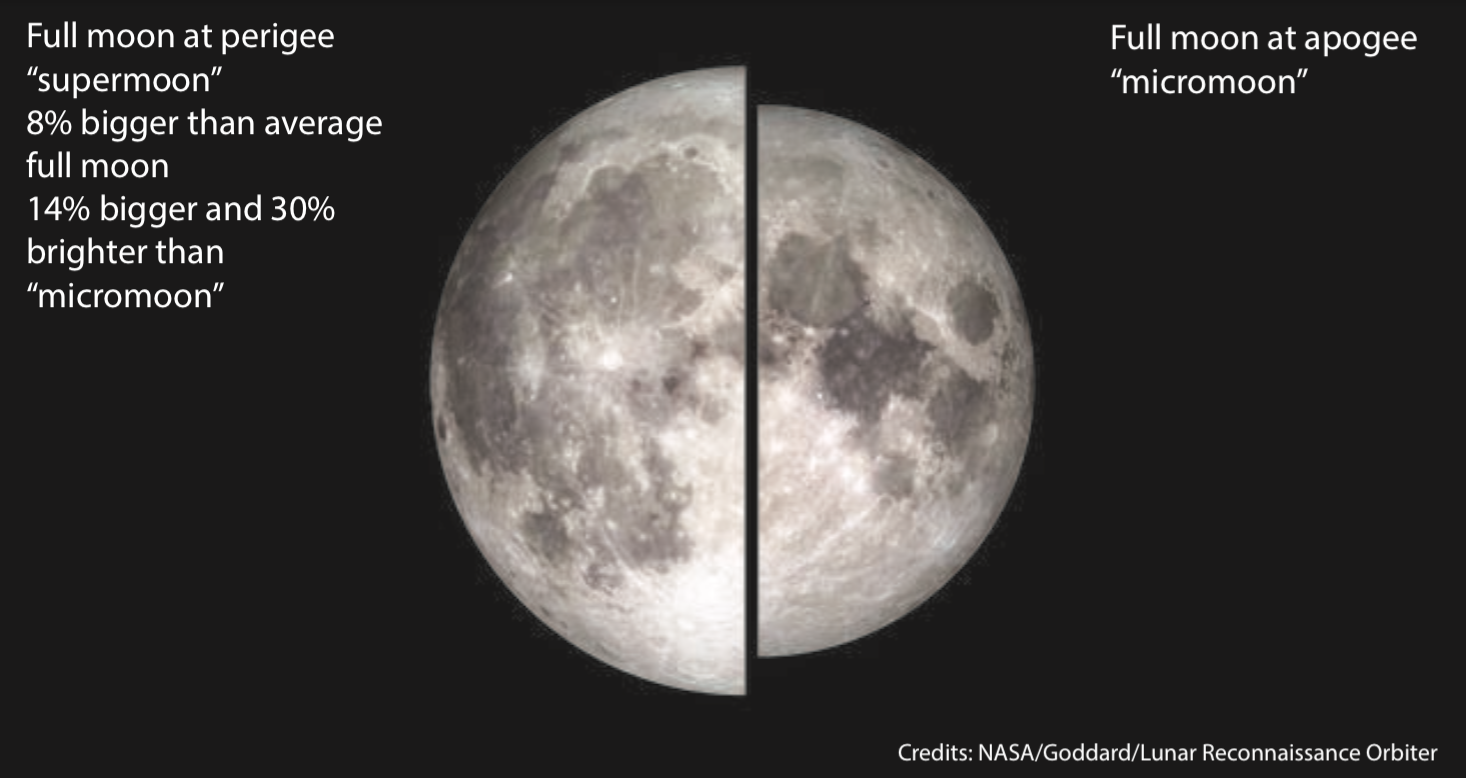
Why are the synodic and sidereal periods not equal to each other? For a reason similar to the reason why the solar day and sidereal day are not the same. Remember that a solar day was slightly longer than a sidereal day because of the Sun's apparent motion around the Earth (which is really due to the Earth's motion around the Sun). The Sun's eastward drift against the stars also means that the Moon's synodic period is longer than its sidereal period.
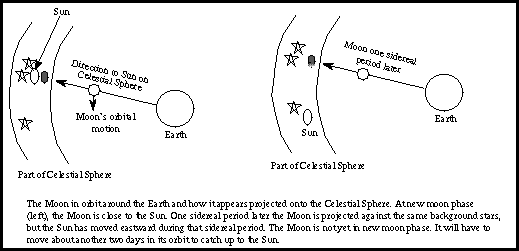
At new moon, the Sun and Moon are seen from the Earth against the same background stars. One sidereal period later, the Moon has returned to the same place in its orbit and to the same place among the stars, but in the meantime, the Sun has been moving eastward, so the Moon has not yet caught up to the Sun. The Moon must travel a little over two more days to reach the Sun and establish the new moon geometry again.
The modern model has the Moon going around the Earth with the Sun far away. At different positions in its orbit you see different phases all depending on the relative positions of the Earth-Moon-Sun. Another possible model was presented by highly-esteemed Harvard seniors at their graduation. They seriously proposed that the dark part of the Moon is the result of portions of the Moon lying in the shadow of the Earth. Many other people have also explained the phases with this Earth shadow model, but I will call this the ``Harvard model'' below.
Since the Moon would need to be opposite the Sun for it to be in the Earth's shadow, the ``Harvard model'' predicts Sun-Moon angles that are very different from the observed angles. In addition, the model predicts that the Moon would need to be one-half a rotation (or 12 hours) away from the Sun. The Moon should rise 12 hours after sunrise (i.e., at sunset), cross the meridian 12 hours after the Sun, and set 12 hours after sunset (i.e., at sunrise) for all of the phases except full. How is this different from what is observed?
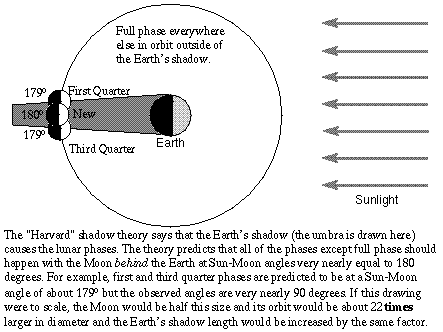
Test and improve your understanding of the lunar phases with the UNL Astronomy Education program's Lunar Phase Simulator. A space view from high above the Earth showing the Moon's orbit and the on Earth view are used to show how the Sun-Moon geometry gives rise to the phases (and how the Earth's shadow cannot!). Also, see NASA/JPL's "Modeling the Earth-Moon System" classroom activity for creating a scale model of the Earth-Moon system.
| lunar eclipse | solar eclipse | synodic period |
|---|
![]() Go back to previous section --
Go back to previous section --
![]() Go to next section
Go to next section
last updated: January 18, 2022